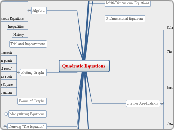Course connections
Unit 1.5, 8.1
Inverse Functions
Unit 5.5, 4.3
Inequalities
Unit 5.6, 4.4, 2.1-2.2, 6.7
These units talk about average rate of change and Instantaneous Rate of Change
Unit 6.4, 8.2
These units both use graph transformations (a,k,d,c)
Advanced Functions CPT
Functions and Characteristics
Transformations of Function
y=af(k(x-d))+c
a:
if a>0, vertical stretch
if 00, horizontal compression by 1/k
if 00, function is moved d units to the right
if d<0, functions is moved d units to the left
c:
if c>0, function is moved c units up
if c<0, function is moved c units down
Attributes
Domain - set of all possible inputs for a function
Range - a set of all possible output of a function
Intervals of Increase - points of a function where the function increases
Discontinuity - a break in the graph
Even/Odd Function - if the graph is reflected across the y-axis (even); of not odd
End behaviour - behaviour of f(x) as x approaches +/- infinity
What is a function?
Definition - a function is a relation in which there is a unique output for each input. Each value of the domain (x-value) corresponds to only one y-value
Exponential and Logarithm Functions
Log Laws
Product law: log(a)xy = log(a)x+log(a)y
Quotient law: log(a)(x/y) = log(a)x-log(a)y
Power law: log(a)xr = r log(a)x
Solving Equations
To solve exponential equations:
a) give both sides a common base and solve for the exponent
b) rewriting it in logarithm form and solving
What is a logarithm function?
The logarithm is the inverse of the exponential function y=ax
y=a(log(a)k(x-d)+c OR a((y-c)/a)=k(x-d)
Base is 'a' (which is equal to 10, unless stated otherwise), exponent is y, argument x
This function is used to find the exponent of certain equations
Trigonometric Identities and Equations
Solving Trig Equations
a) only find solutions within given interval
b) use special triangles, the unit circle and graphs to find all solutions of x within the interval, if possible
c) when solving a quadratic equation, remove sin/cos/tan to make it simpler to solve, but remember to ass it back once factored
d) Use quadratic formula if quadratic equation is not factorable
How to prove trig identities
a) Simplify the more complicated side until it is identical to the other side, or manipulate both sides to get the same expression
b) rewriting expressions using identities you know
c) use a common denominator or factor, if possible
Formulas
Compound angle formulas:
cos(a+b) = cosacosb - sinasinb
cos(a-b) = cosacosb + sinasinb
sin(a+b) = sinacosb + cosasinb
sin(a-b) = sinacosb - cosasinb
tan(a+b) = (tana + tanb)/(1-tanatanb)
tan(a-b) = (tana - tanb)/(1+tanatanb)
Double angle formulas:
cos(2x) = cos2x - sin2
= 1-2sin2x
= 2cos2x - 1
sin(2x) = 2sinxcosx
tan(2x) = 2tanx/(1-tan2x)
Pythagorean Theorem
sin2x + cos2x = 1
tan2x + 1 = sec2x
1 + cot2x = csc2x
Trigonometric Functions
|a| is the amplitude
- a=(max-min)/2
|k| is the number of cycles in 2pi radians
- p=2pi/k
y = c is the equation of axis
Radians to degrees:
multiply by 180/pi
Degrees to radians:
multiply by pi/180
csc x = 1/sinx
sec x = 1/cosx
cot x = 1/tanx
Polynomial and Rational Functions
Rational Functions, Equations, and Inequalities
Solving Rational Equations and Inequalities
To solve a rational equation
a) cross multiply
b) multiply all terms by the lowest common denominator
To solve an Inequality
a) all terms to one side and set it equal to 0
b) use an interval table to find where the inequality is true
To graph rational functions, use interval table, using the factors of the function to find where f(x) is negative or positive in relation to the asymptotes and zeros
Asymptotes
f(x)=axn/(bxm)
zero of the denominator = vertical asymptote
ratio of leading coefficients in numerator and denominator = horizontal asymptote
n>m:
horizontal asymptote at y=0
n=m:
horizontal asymptote at y=a/b
n>m by 1:
oblique asymptote
if numerator and denominator has a common factor of (x-a): graph has a hole at a
Polynomial Equations and Inequalities
Solving Linear Inequalities and Equations
Solving linear equations
- Bring all the number to one side, to isolate for x
- Cross-multiply, multiply by the same denominator,
add, subtract, from both sides as needed.
Solving linear inequalities is the same as solving linear equations except...
- If you multiply or divide by a negative number, you
MUST flip the sign
- Linear inequalities could have multiple solutions
1) Move all terms to one side and use the remainder theorem and synthetic division to factor fully
2a) If it is an equation (set equal to zero):
set each factor equal to zero to find the zeros of
the function
2b) If it is an inequality (set to greater than or less than zero)
- Create an interval table to identify where the
f(x) is greater or less than zero
Factoring Polynomials
Remainder theorem:
f(a)=0 when (x-a) is a factor of f(x). Numbers that could make f(x)=0 are of the p/q, where p is a factor of the constant term of the polynomial, and q is a factor in the leading coefficient.
A sum of cubes:
A^3-B^3=(A+B)(A^2+AB+B^2
A difference of cubes:
A^3-B^3=(A-B)(A^2+AB+B^2)
Dividing Polynomials
Standard Division:
follow standard long division rules, using a dividend, divisor, remainder, and quotient
Synthetic Division:
Can only be used if the divisor is linear (x-k) or (ax-k)
1. terms should be arranged in a descending order of degree
2. to find divisor, set x-k=0 and solve for x
3. zero must be used as the coefficient of any missing power
Characteristics
If the degree is odd....
if the Leading Coefficient is (-), f(x) goes from the second quadrant to the fourth quadrant
if the Leading Coefficient is (+), then f(x) goes from the third quadrant to the first quadrant
It must have at least one zero (x-intercept)
It must have an even number of turning points between 0-n
If the degree is even...
if the Leading Coefficient is (-), f(x) goes from the third quadrant to the first quadrant
if the Leading coefficient is (-), f(x) goes from the second quadrant to the first quadrant
can have up to n(degree) zeros or none at all
odd number of turning points between 0-n
Definitions
Degree - the sum of the exponents of the variable in a term
Degree of a function - the degree of the greatest degree term
Leading coefficient - the coefficient of the term with the highest degree in the polynomial
Absolute max/absolute min - the greatest/least value attained by a function
What is a polynomial function?
A polynomial function is a function of the form f(x)=ax^2+ax+a, where a is a real and whole number.
Photo of examples
Characteristics of Functions
Instantaneous Rate of Change
Rate of Change in graphs
Tangent line - a line that touches the graph only on one point, P, within a small interval of a relation
The slope of the tangent line can only be estimated, not calculated, because only one point is known. The slope is equivalent to the instantaneous rate of change at point P.
Secant line - a line that passes through two points on the graph of a relation.
Graphically, average rate of change over an interval between x1 and x2 is equivalent to the slope of a secant line through points (x1, y1) and (x2, y2)
Instantaneous Rate of Change is the exact rate of
change of a function y=f(x) at a specific value of the
independent value x=a
It's estimated using average rates of change over very
small intervals of the independent value
Methods to calculate the IROC
Difference Quotient - finding the average rate of change
between a and x+h, where h is a very small positive number
(0.01)
Centered Interval - finding the average rate of change
between x-h and x+h, where h is a very small positive number (0.01)
Following Interval - finding the average rate of change
between (x, f(x)) and (x+h, f(x+h)), where h is a small positive value (0.01)
Preceding Interval - finding the average rate of change
between (x-h, f(x-h)) and (x, f(x)), where h is a small positive number (0.01)
Average Rate of Change
What is it?
Average rate of change is the change in y divided by the change in x, over an interval
AROC= 𐤃y/𐤃x
=f(x2)−f(x1)/x2-x1
AROC=𐤃y
𐤃x
= f(x2)









